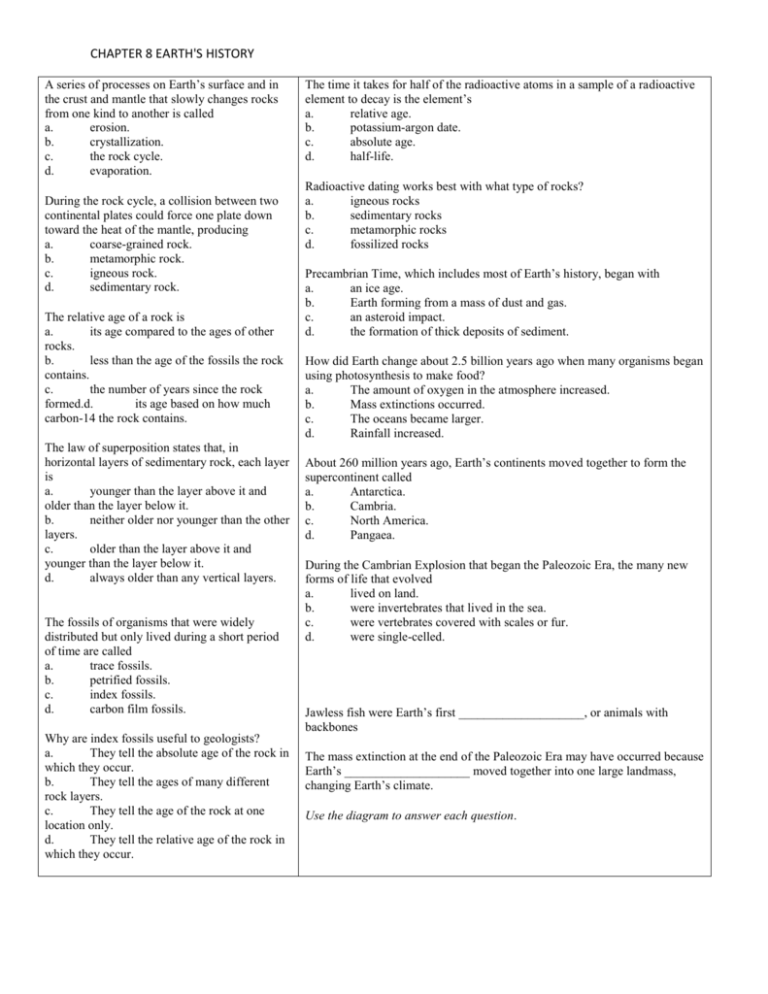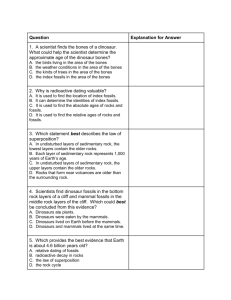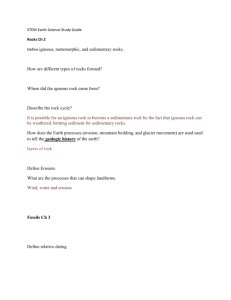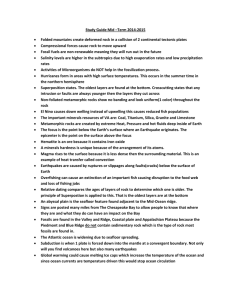work on test review
advertisement

CHAPTER 8 EARTH'S HISTORY A series of processes on Earth’s surface and in the crust and mantle that slowly changes rocks from one kind to another is called a. erosion. b. crystallization. c. the rock cycle. d. evaporation. During the rock cycle, a collision between two continental plates could force one plate down toward the heat of the mantle, producing a. coarse-grained rock. b. metamorphic rock. c. igneous rock. d. sedimentary rock. The relative age of a rock is a. its age compared to the ages of other rocks. b. less than the age of the fossils the rock contains. c. the number of years since the rock formed.d. its age based on how much carbon-14 the rock contains. The law of superposition states that, in horizontal layers of sedimentary rock, each layer is a. younger than the layer above it and older than the layer below it. b. neither older nor younger than the other layers. c. older than the layer above it and younger than the layer below it. d. always older than any vertical layers. The fossils of organisms that were widely distributed but only lived during a short period of time are called a. trace fossils. b. petrified fossils. c. index fossils. d. carbon film fossils. Why are index fossils useful to geologists? a. They tell the absolute age of the rock in which they occur. b. They tell the ages of many different rock layers. c. They tell the age of the rock at one location only. d. They tell the relative age of the rock in which they occur. The time it takes for half of the radioactive atoms in a sample of a radioactive element to decay is the element’s a. relative age. b. potassium-argon date. c. absolute age. d. half-life. Radioactive dating works best with what type of rocks? a. igneous rocks b. sedimentary rocks c. metamorphic rocks d. fossilized rocks Precambrian Time, which includes most of Earth’s history, began with a. an ice age. b. Earth forming from a mass of dust and gas. c. an asteroid impact. d. the formation of thick deposits of sediment. How did Earth change about 2.5 billion years ago when many organisms began using photosynthesis to make food? a. The amount of oxygen in the atmosphere increased. b. Mass extinctions occurred. c. The oceans became larger. d. Rainfall increased. About 260 million years ago, Earth’s continents moved together to form the supercontinent called a. Antarctica. b. Cambria. c. North America. d. Pangaea. During the Cambrian Explosion that began the Paleozoic Era, the many new forms of life that evolved a. lived on land. b. were invertebrates that lived in the sea. c. were vertebrates covered with scales or fur. d. were single-celled. Jawless fish were Earth’s first ____________________, or animals with backbones The mass extinction at the end of the Paleozoic Era may have occurred because Earth’s ____________________ moved together into one large landmass, changing Earth’s climate. Use the diagram to answer each question. CHAPTER 8 EARTH'S HISTORY During the Devonian Period, animals that could live on land began to evolve. These animals still spent part of their lives in the water. What were these animals called? a. trilobites b. reptiles c. amphibians d. dinosaurs What do most scientists think caused the mass extinction of dinosaurs and other organisms at the end of the Cretaceous Period? a. Volcanic eruptions covered large areas with lava. b. An object from space struck Earth. c. An ice age covered most of Earth with ice. d. The dinosaurs ate too many other organisms and then starved. Scientists believe that the sun is 4.6 billion years old, approximately the same age as Earth. _________________ A series of processes known as the ____________________ slowly changes rocks from one kind to another kind. A(n) ____________________ is a gap in the geologic record where some rock layers have been lost because of erosion. Certain ammonites are used as ____________________ fossils because they lived in many different areas but for only a brief time. Certain ammonites are used as ____________________ fossils because they lived in many different areas but for only a brief time. The time it takes for one half of the atoms in a sample of a radioactive element to decay is called the element’s ____________________. Life first appeared around 3.5 billion years ago, about _________________ years after the formation of Earth. Potassium-40 is useful for dating very old rocks because it has a(n) ____________________ of 1.3 billion years. Which sedimentary rock layer is older, A or B? Explain your answer and name the scientific law that you applied to reach your conclusion. List layers E, D, and C in order from oldest to youngest. If layer C is sedimentary rock and layer G is igneous rock, which would be more likely to contain fossils? Explain your answer. CHAPTER 8 EARTH'S HISTORY








